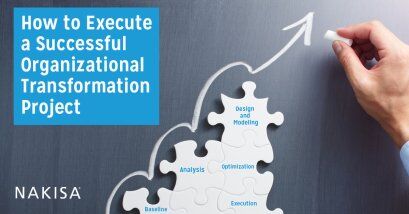Organizational Transformation projects arise for a variety of different reasons, including the need to support rapid growth, merger & acquisition (M&A) integration, efficiency-focused reorganization, and/or geographic expansion.
No matter what the driving force for organizational change is, a well-planned transformation project typically involves a series of similar preparatory, analysis and execution activities. This blog post outlines the best practices to ensure success and includes some considerations for a supporting solution.
1. Establishing a Baseline:
This essential first step involves creating a clear picture of the existing organization to use as a starting point from which to achieve the desired change goals. Key variables that should be determined in this step include defining the project deliverables, work functions, roles, talent skills, etc. In addition to taking inventory of the current situation, one should also establish ownership for the reorganization project, timeframes for subsequent steps and the process for management reviews during the project.
2. Comprehensive Analysis
The analysis step is the first deep dive into the specific detail of the organizational skills, assets, needs, gaps, and options required to move the project forward. During this step, it is recommended to collect information from different data sources and compile it into a comprehensive repository for visualization and analysis.
It is virtually impossible to manage a complex transformation project without first unifying all relevant information in an analysis database. Utilizing a comprehensive approach to support organization transformation ensures that there is an organizational analysis and modeling environment that can support all steps of the transformation from baseline definition to optimization.
During the Comprehensive Analysis step, a number of key variables need to be addressed:
- a. Align the planned work functions and roles to support new business strategies
- b. Assess talent, skills and data to highlight gaps, vulnerabilities and opportunities
- c. Prepare talent strategy options, such as developing, acquiring or partnering
3. Organizational Design and Modeling
In the design step, it will be highly valuable to model multiple organizational scenarios that address the business objectives from different viewpoints. Similarly, to step number two, it is important to use a comprehensive solution that combines a unified information repository with a variety of analysis, visualization and modeling tools. Lacking the ability to easily review and assess a variety of different options, increases the risk that the reorganization team will decide on a strategy too quickly, which may result in an organizational structure that is not optimal.
The key goals for the Design and Modeling process follow:
- Decide on the best option(s) to achieve the organizational change goals
- b. Collaborate with decision makers and stakeholders
- c. Agree on the final model for implementation
4. Execution and Implementation
Using secure collaborative features, the core team can confidentially share final models with key managers in the organization in order to coordinate the execution process. Re-organization project managers and key stakeholders can receive on-going progress feedback as changes are piloted. Additionally, they can easily respond and address any questions or concerns related to the process.
It is also important to note that the organization transformation solution should support bi-directional communication with all core HCM solutions in order to write-back changes and keep HR records aligned with the new organizational structure.
5. Align and Optimize
As the organization transformation process nears completion, it is crucial to measure the results, make adjustments for optimal alignment, and track if ROI and efficiency goals will be achieved. Similarly, to previous steps, using a comprehensive re-organization solution enables continuous closed-loop feedback between the original goals, the design and the actual results.
Putting all the Pieces Together
While each of the steps described above is key to the success of the overall organizational transformation project, it is also important to remember that all of the steps need to be seamlessly linked together within a unified process. Organizational transformation is an inherently fluid process that often requires multiple iterative feedback loops to test assumptions and to make improvements.
In order to achieve optimal results in the shortest timeframe, all data collection, analysis, modeling, execution, and optimization steps must be combined within a single unified solution that supports real-time communications, visualization, analysis and metrics.
From its inception, Nakisa’s HR Suite solution (formerly HANELLY) has been developed specifically to address these challenges with a comprehensive, intuitive, and unified solution that optimizes visibility, analytics, design, modeling, measurement, and communications throughout the organizational transformation process.
Click here to read more about organizational transformation use cases or contact us for additional information.






